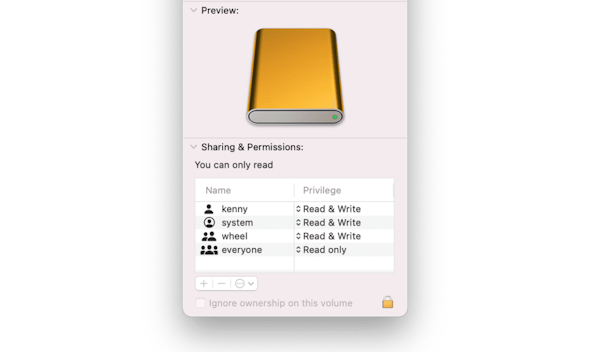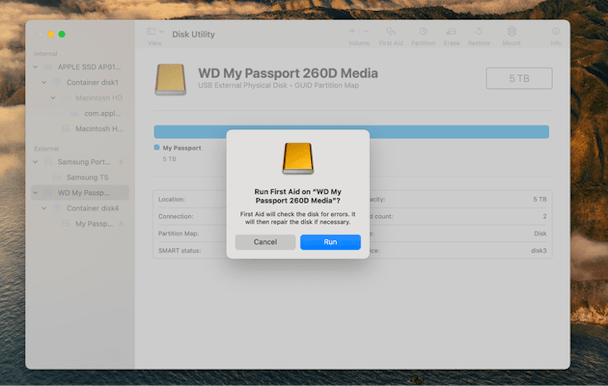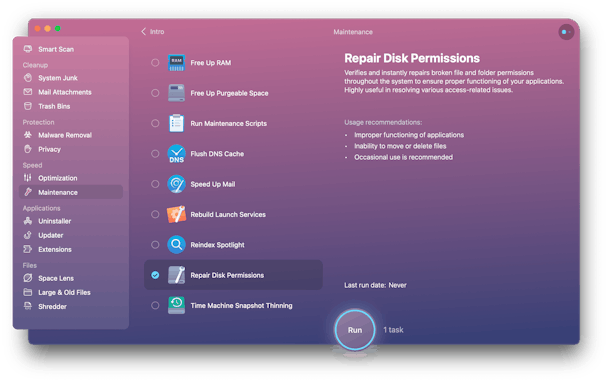Can You Label an Ssd as Read Only
Most of us use some kind of external storage device with our Mac at some time or some other, whether it'due south a USB stick, wink bulldoze, external hard disk, or SSD. Most of the time, at that place's no problem. However, yous may run across errors now and over again, and one of the nearly mutual is that your Mac is unable to write to the disk. You may meet a message telling y'all that the drive is read-only. Fortunately, it's not too difficult to fix the problem. In this commodity, we'll show y'all how.
What causes the "read-only" error?
There are two possibilities when you see a message telling you a hard drive, USB stick, or other external storage media is read-only.
- The bulldoze is formatted in a way that ways your Mac tin can read it simply not write to it. This can happen with disks that are formatted as NTFS.
- Some permissions settings prevent your Mac or your user account from writing to the disk.
To decide which of these is causing the trouble, select the disk in the Finder and press Control-I, or right-click it and choose Get Info.
Under General, you should run into a list of parameters. Expect at the 1 named Format. If it says NTFS, that'south the trouble.
If the Format is APFS, macOS Extended, or Fat 32, then that is not the problem, and you'll need to check permissions.

- Await at the bottom of the Get Info window.
- Under Sharing & Permissions, it will tell you what access you have. If it says "read-only," y'all know the problem is permissions-related.
How to alter permissions on an external difficult drive on your Mac
The following applies whether the bulldoze in question is a hard drive, USB stick, SSD, or any other external media. At that place are several options, depending on what y'all identified as causing the problem.
How to set hard drive read-simply issue
In that location are two options here. One is to reformat the bulldoze to a format your Mac can write to as well every bit read. This volition wipe all the information from information technology, so you should make a backup or manually copy of import files to some other location first. Depending on how you lot format it, it may also cause problems if yous need to use the drive with a Windows PC. So, but choose this option if y'all know the drive will just be used with Macs in the future.
The other choice is to employ third-party driver software to enable your Mac to write to an NTFS-formatted disk. In that location are a number of paid-for and some complimentary options available.
How to reformat an external drive:
- With the drive plugged into your Mac, become to Applications > Utilities and launch Disk Utility.
- Cull the external deejay in the Disk Utility sidebar.
- Select the Erase tab.
- Type in a name for the reformatted drive.
- Select MacOS Extended (Journaled) from the dropdown bill of fare.
- Printing Erase.
- The drive will be wiped, reformatted, and when it's washed, your Mac will exist able to write to information technology.
How to fix permissions issues
If the bulldoze is correctly formatted for the Mac and you tin can't write to it, the trouble is likely to be related to permissions. Here's how to fix it.
- Select the bulldoze in the Finder.
- Press Command-I to display the Get Info window.
- At the bottom of the window, click the pointer adjacent to Sharing & Permissions to display permissions.
- Click on the Privilege menu next to your username and cull Read & Write.
- Shut the Get Info window.
If your user business relationship is not an admin user, you lot may take to use the padlock to unlock permissions settings and type in an admin username and password. You may also need to restart your Mac to get the change to accept issue.
In some circumstances, you may not be able to change permissions in the Finder, or doing so may not fix the trouble. If that happens to you, the adjacent step is to use Disk Utility to fix the disk.

- Go to Applications > Utilities and launch Disk Utility.
- Select the external deejay in the sidebar.
- Click on First Aid.
- Printing Run to ostend that you lot want to try and repair the deejay.
In versions of macOS up to and including macOS x.x Yosemite, y'all could use Deejay Utility to repair permissions. The option appears in the Start Aid tab with two buttons, ane to verify and one to repair permissions. If you are running a version of macOS where these options are bachelor, you lot should use them instead of the steps described higher up.
If you encounter an issue where a difficult drive is read-merely on your Mac, or mayhap a USB stick or flash bulldoze, it may exist that information technology is formatted as NTFS, which can be read by macOS merely not written to. Information technology may also be a permissions issue. If you follow the steps in this commodity, you'll exist able to identify which information technology is and fix it apace.
valtierrautmacksmay.blogspot.com
Source: https://macpaw.com/how-to/hard-drive-read-only-permission

0 Response to "Can You Label an Ssd as Read Only"
Post a Comment